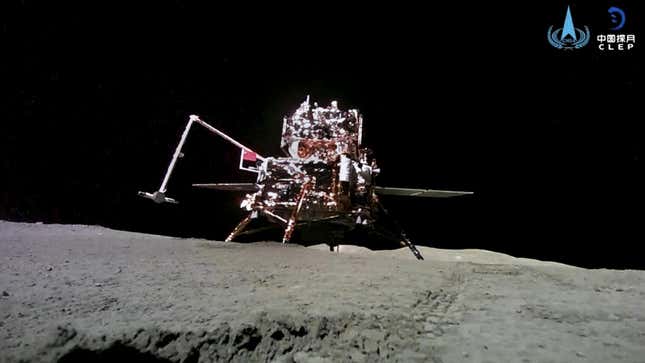
After a short visit to the Moon’s far side, a Chinese spacecraft loaded with lunar rock and dust has started its return trip to Earth to deliver these precious samples.
China’s Chang’e 6 mission ascent vehicle lifted off from the Aitken Basin on the lunar south pole on Monday at 7:38 p.m. ET (7:38 a.m. Beijing time on Tuesday), and is on its way back home, according to the China National Space Administration (CNSA).
Chang’e-6 launched from the Wenchang Satellite Launch Center on May 3 and arrived on the Moon nearly one month later. The spacecraft touched down on Aitken Basin, the largest and oldest impact crater on the Moon’s far side. This crater may have exposed parts of the Moon’s mantle by blasting it to the surface. By grabbing samples from this impact crater, the mission could help scientists understand early impacts that helped shape Earth and the Moon and why the lunar far side is different than its near side counterpart.
After hanging out on the Moon for two days, a section of the spacecraft separated from the lander and shot into lunar orbit. There, the ascent vehicle is meant to dock with the mission’s service module in orbit, which will place the samples in a capsule headed for Earth.
The goal was for the spacecraft to collect 2,000 grams of lunar materials using an onboard drill. The mission is scheduled to arrive at Earth and deliver the samples on June 25.
China has returned materials from the Moon before with its Chang’e 5 mission, which made history by returning lunar samples to Earth for the first time in more than 40 years. This time, however, the country’s ambitious space program is hoping to become the first to return samples from the far side of the Moon.
Unlike the lunar hemisphere facing Earth, the far side is more densely populated with impact craters while largely missing the large, dark seas of cooled lava that dominate the Moon’s near side. There is very little known about the far side of the Moon compared to its near side, and scientists are hoping the samples can help answer questions about the origins of Earth’s natural satellite.
For more spaceflight in your life, follow us on X and bookmark Gizmodo’s dedicated Spaceflight page.

